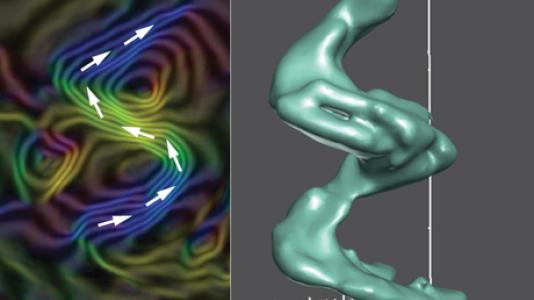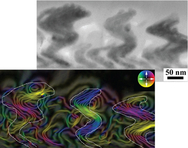
Scientific Achievement
Three-dimensional (3D) visualization of magnetic domains and interactions at the nanoscale
Significance and Impact
Gained a fundamental understanding of interactions between nanoscale building blocks that control the properties of the mesoscopic system
High-Level Research Details
The magnetic interactions occurring at the nanoscale in arrays of cobalt nanospirals with 20-nm wire diameter were analyzed in 3D by using aberration-corrected Lorentz transmission electron microscopy.
In combination with 3D electron tomography and modeling, we showed that the magnetic domain structure is controlled by the shape anisotropy energy, which dominates over the magnetocrystalline anisotropy energy of the nanostructure.
Additional Information
Confined magnetic nanostructures can exhibit novel emergent phenomena such as magnetic monopole defects, emerging from the competition between various energy terms. To achieve successful control over such phenomena, it is critical to understand the energetics of these systems in all three dimensions.
In this work, we report on the direct visualization of magnetic structure in individual sculpted 3D cobalt (Co) nanospirals with a wire diameter of 20 nm. Using aberration-corrected Lorentz transmission electron microscopy, we were able to image and analyze the magnetic interactions occurring at the nanoscale.
Using a combination of 3D tomography and high resolution TEM, we were able to elucidate that the magnetic structure of these nanospirals is controlled by the shape anisotropy energy dominating over the magnetocrystalline anisotropy energy. Thin films consisting of arrays of such sculpted nanostructures are potential candidates for a large variety of applications in the fields of photonics and optics as polarization filters, and as tissue scaffolds in biomedical applications.
This research paves a path toward a clearer fundamental understanding of interactions between nanoscale building blocks, thereby enabling control of the properties of the mesoscopic system of which they form a part.
Research Team
Charudatta Phatak, Amanda Petford-Long (Argonne Materials Science Division); Yuzi Liu (Argonne Center for Nanoscale Materials); Eva Schubert, Daniel Schmidt (University of Nebraska-Lincoln); Emine B. Gulsoy (Northwestern University)
Sponsors
U.S. Department of Energy Office of Science, Materials Science and Engineering Division; National Science Foundation
Reference
C. Phatak, Y. Liu, E. B. Gulsoy, D. Schmidt, E. Schubert, and A. Petford-Long, Nano Letters, 14(2), 759 (2014) doi://10.1021/nl404071u.
Acknowledgments
C.P., Y.S. and A.P.-L. supported by the US Department of Energy (DOE), Office of Science, Materials Science and Engineering Division. D.S. and E.S. acknowledge funding through NSF MRSEC (DMR-0820521), CAREER (ECCS-0846329) and RII (EPS-1004094). We would also like to acknowledge the use of Electron Microscopy Center at Argonne National Laboratory, and we thank Beri Mbenkum (Max Planck Institute for Intelligent Systems) for supplying the prepatterned substrate. Fabrication of nanospirals was done at University of Nebraska-Lincoln; Lorentz TEM, 3D tomography, Analysis of magnetic domains and interactions was done at Argonne National Laboratory; Image processing of 3D data was done at Northwestern University.
